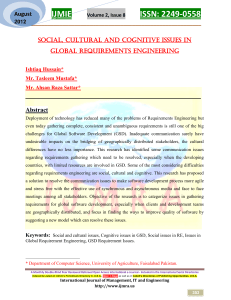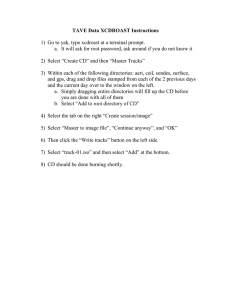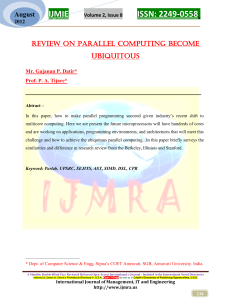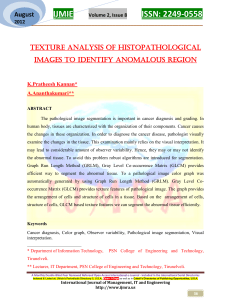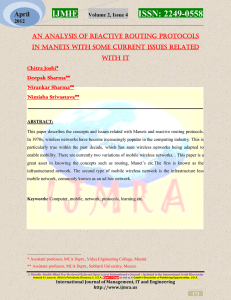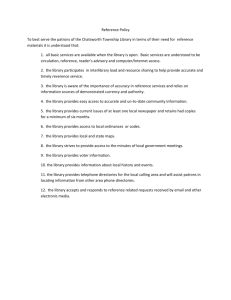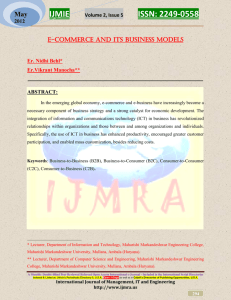IJMRA-MIE1528
advertisement
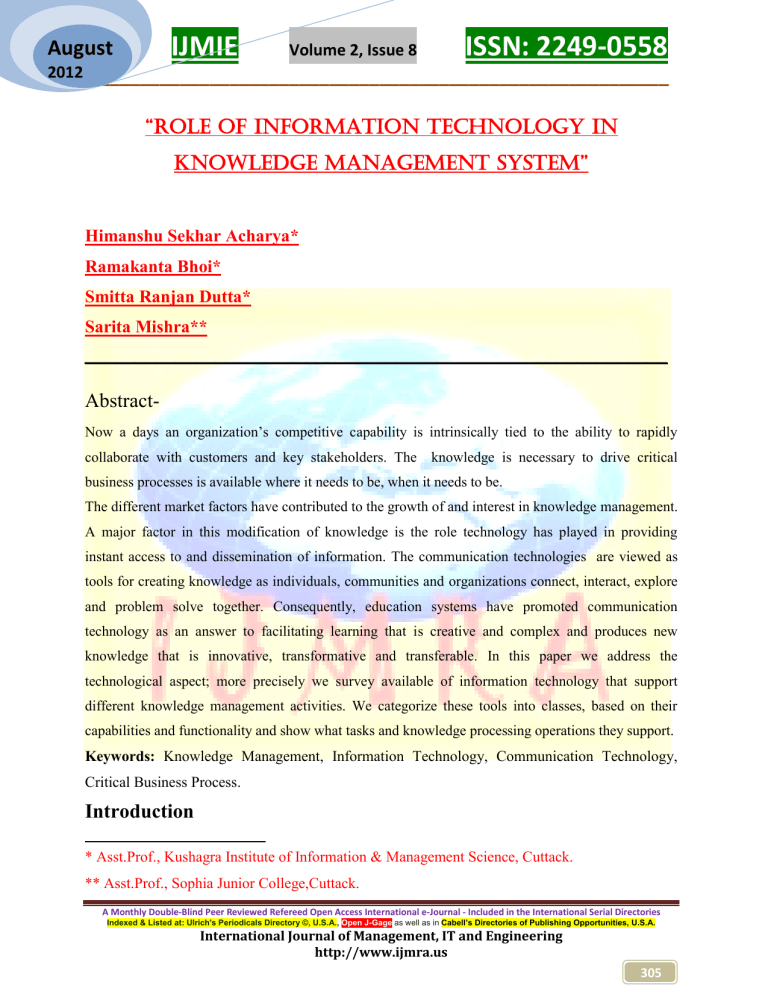
IJMIE August Volume 2, Issue 8 ISSN: 2249-0558 2012___________________________________________________________ “Role of Information Technology in Knowledge Management System” Himanshu Sekhar Acharya* Ramakanta Bhoi* Smitta Ranjan Dutta* Sarita Mishra** __________________________________________________________ AbstractNow a days an organization‟s competitive capability is intrinsically tied to the ability to rapidly collaborate with customers and key stakeholders. The knowledge is necessary to drive critical business processes is available where it needs to be, when it needs to be. The different market factors have contributed to the growth of and interest in knowledge management. A major factor in this modification of knowledge is the role technology has played in providing instant access to and dissemination of information. The communication technologies are viewed as tools for creating knowledge as individuals, communities and organizations connect, interact, explore and problem solve together. Consequently, education systems have promoted communication technology as an answer to facilitating learning that is creative and complex and produces new knowledge that is innovative, transformative and transferable. In this paper we address the technological aspect; more precisely we survey available of information technology that support different knowledge management activities. We categorize these tools into classes, based on their capabilities and functionality and show what tasks and knowledge processing operations they support. Keywords: Knowledge Management, Information Technology, Communication Technology, Critical Business Process. Introduction * Asst.Prof., Kushagra Institute of Information & Management Science, Cuttack. ** Asst.Prof., Sophia Junior College,Cuttack. A Monthly Double-Blind Peer Reviewed Refereed Open Access International e-Journal - Included in the International Serial Directories Indexed & Listed at: Ulrich's Periodicals Directory ©, U.S.A., Open J-Gage as well as in Cabell’s Directories of Publishing Opportunities, U.S.A. International Journal of Management, IT and Engineering http://www.ijmra.us 305 August IJMIE Volume 2, Issue 8 ISSN: 2249-0558 2012___________________________________________________________ Knowledge is one of the vital information which enhances the performance of the business. Many businesses are human and knowledge intensive. Examples include consulting, advertisement, media, high-tech, pharmaceutical, law, software development, and other human capital-based organizations. Knowledge intensive organizations have realized that a large number of problems are attributed to un-captured and un-shared product and process knowledge, as well as the need to know „who knows what‟ in the organization, the need for distance collaboration, and the need to capture lessons learned and best practices. These realizations have led to a growing call for knowledge management (KM). The quality of the Knowledge can increase if you will sharing, learning, utilizing the knowledge repeatedly. It‟s sharing is more efficient when knowledge must be captured, stored and organized according to the context of each company in order for it to be useful as well as efficiently disseminated. Knowledge items that an organization needs to manage have different forms and content. They include manuals, correspondence with vendors and customers, news, competitor intelligence, and knowledge derived from work processes (e.g. documentation, proposals, project plans, and postmortem analyses) in different formats (e.g. text, pictures, audio, or video). The amount of information and knowledge in a modern organization that needs to be captured, stored and shared, the geographic distribution of sources and consumers, and the dynamic evolution of information make the use of technology support not an option, but a necessity. In this paper we emphasize on how information technology/communication technology that support KM for efficiently manage the business activities. The paper speaks to organizations that want to implement KM by facilitating their decisions regarding what systems to buy or implement. This paper also helps system developers and vendors to form a picture of the market, its potential gaps and opportunities. And, finally, this paper aids researchers to identify trends and future work in the KM domain. Knowledge Description A Monthly Double-Blind Peer Reviewed Refereed Open Access International e-Journal - Included in the International Serial Directories Indexed & Listed at: Ulrich's Periodicals Directory ©, U.S.A., Open J-Gage as well as in Cabell’s Directories of Publishing Opportunities, U.S.A. International Journal of Management, IT and Engineering http://www.ijmra.us 306 August IJMIE Volume 2, Issue 8 ISSN: 2249-0558 2012___________________________________________________________ Knowledge is a level higher than information. Knowledge resides in the minds of knower‟s. It is a fluid mix of contextual structured and unstructured raw material that is transferred into valuable knowledge assets that can be renewed, grown, and acted upon. Knowledge is an inherently human state of affairs, while information is what resides in mindless computers. Many agree with the definition that “knowledge” is not only personal, it is also an evolutionary mental process – we formulate and structure what we know. Knowledge also includes intuitive and spontaneous responses to the environment in which we find ourselves. Knowledge Management Knowledge management is a concept in which all untapped and unconnected knowledge is systemically collected, structured, and distributed enterprise-wide to support effective decision making and improvement of competitive advantage. The different integral components of knowledge management are • Formation of new knowledge from the existing knowledge • Collecting the valuable knowledge from the different resources. • Use the organizational knowledge in decision-making • Representing knowledge in documents, databases, and software • Facilitating knowledge growth through culture and incentives • Transferring existing knowledge into other parts of the organization • Measuring the value of critical knowledge assets Goal of Knowledge Management The main goal of knowledge management (km) is to deliver value to an organization. The KM is the valuable knowledge resources and knowledge capabilities of the business to provide the organization to learn and use to its changing environment. Therefore, KM practices aim to draw out the tacit knowledge people have acquired, what they carry around with them, what they observe and learn from their experience, rather than what is usually explicitly stated. The knowledge executive process is about acquisition, creation, packaging, and application or reuse of knowledge. A Monthly Double-Blind Peer Reviewed Refereed Open Access International e-Journal - Included in the International Serial Directories Indexed & Listed at: Ulrich's Periodicals Directory ©, U.S.A., Open J-Gage as well as in Cabell’s Directories of Publishing Opportunities, U.S.A. International Journal of Management, IT and Engineering http://www.ijmra.us 307 August IJMIE Volume 2, Issue 8 ISSN: 2249-0558 2012___________________________________________________________ Information Technology for Knowledge Management KM should be supported by a collection of technologies for authoring, indexing, classifying, storing, contextualizing and retrieving information, as well as for collaboration and application of knowledge. A friendly front-end and a back-end are the basic necessities of a software tool for knowledge management. The explicit knowledge resides in repositories as documents or other types of knowledge items (e.g., e-mail messages and database records). Standard authoring tools (such as word processors) and database management systems (DBMS) are also very much useful for efficiently managing the knowledge of an organization. File servers, e-mail tools and Internet and intranet services support the infrastructure for knowledge management document and content management systems handle knowledge repositories. Knowledge must be organized according to the context of each organization, based on a corporate taxonomy that creates a “knowledge map”, supported by classifying and indexing tools. Knowledge can be distributed as needed by different users and applications, such as e-learning, competence management, intellectual property management, and customer relationship management. It is difficult to draw a line between what is called information technology (IT) and tools for KM. We discuss the needs of employees that use knowledge, the types of knowledge conversion that occur and a common set of features provided by systems from each category. The systems we selected to analyze are those that are widely used for supporting the KM. This survey is not intended to cover all systems on the market but rather to give the reader a sense of the various systems that are available for knowledge management. Much of the information in this section is based on information gathered from manufacturers' websites and other promotional materials. Documentary Report based on Container Tool Management A Monthly Double-Blind Peer Reviewed Refereed Open Access International e-Journal - Included in the International Serial Directories Indexed & Listed at: Ulrich's Periodicals Directory ©, U.S.A., Open J-Gage as well as in Cabell’s Directories of Publishing Opportunities, U.S.A. International Journal of Management, IT and Engineering http://www.ijmra.us 308 August IJMIE Volume 2, Issue 8 ISSN: 2249-0558 2012___________________________________________________________ The knowledge management is the documents that organizations produce to represent their explicit knowledge. New knowledge can be generated from documents like experts can be identified based on ownership of documents. Document management systems enable explicit-to-explicit knowledge conversion. The tacit-toexplicit knowledge conversion occurs when experts are determined based on the documents they created. Expert identification certainly results in knowledge creation. Basic needs that arise in a document-sharing environment are related to identifying the latest version of a document, accessing documents remotely and sharing the documents in workgroups. Document management systems offer features that include storing of documents, control, organization of documents in different ways, search and retrieval based on indexing techniques and advanced searching mechanisms; and access from any Internet connected systems. Most document management systems also provide some kind of search for experts based on ownership. Microsoft SharePoint, which is an example of a document management system, is available in two versions: SharePoint Team Services and SharePoint Portal Server that supports larger workgroups which often require formal publishing processes and the ability to search for and aggregate content from multiple data repositories and file formats. Collaborative Document Management Solution (CDM), improves document management, collaboration, and sharing of corporate functions.CDM provides teams and groups with the ability to share and leverage the knowledge contained within business documents ensuring that the right document is available to the right person or team and at the right time, within from an Internet browser. Main document management features and capabilities include secure workspaces, integration to tools like Microsoft Office, Workflow reporting, and core repository services like check-in/check-out, versioning, and retention. Xerox offers a set of tools that find, store, share, view, represent, and protect documents and thus help uncover knowledge in the digital and paper domains. Xerox FlowPort integrates various paper-driven devices (faxes, photocopiers, etc.) into groupware, e-mail and document management. Xerox DocuShare is a web-based document management system that allows users post and retrieve information in any format (text, scanned images, video clips, MS Office documents, sound files, executables, etc.). A Monthly Double-Blind Peer Reviewed Refereed Open Access International e-Journal - Included in the International Serial Directories Indexed & Listed at: Ulrich's Periodicals Directory ©, U.S.A., Open J-Gage as well as in Cabell’s Directories of Publishing Opportunities, U.S.A. International Journal of Management, IT and Engineering http://www.ijmra.us 309 August IJMIE Volume 2, Issue 8 ISSN: 2249-0558 2012___________________________________________________________ Documentum 5, a document management system from Documentum provides projects with collaborative tools and services, manages enterprise content in an integrated system (including new services for enterprise report management, scanning/imaging, and records management), and enables application development with reusable application components in standard development environments. Documentum 5 supports all content types, including traditional documents, XML, Web content, and rich media and also allows end-to-end encryption for data communication and data storage, and secures content with solutions such as digital rights management and records management. The Lotus Discovery Server extracts, analyzes and categorizes structured and unstructured information to identify the relationships between the content, people, topics and user activity in an organization. The server generates and maintains user profiles and tracks relevant end-user activities, identifying those individuals who may be subject matter experts, and creating an organizational knowledge map. Taxonomy of Organization The tools used in this class are for organizing the unstructured content and knowledge items into a structured map, based on the business objectives of the organization. Research indicate that, today, 80% of business is conducted on unstructured information and 85% of all data stored is held in an unstructured format, therefore the need to extract the knowledge from the unstructured data by organizing it. These tools help build knowledge maps based on organizational objectives, in an intuitive, consistent and logical manner. The organizational maps created by these tools contain categories that taken together are, mutually exclusive and collectively exhaustive. The tools take the explicit knowledge of the knowledge items and turn it into another explicit knowledge by organizing these documents based on taxonomies. These tools also support explicit-to-tacit knowledge conversion, as the knowledge map built by these tools help people better internalize the knowledge. The basic mechanism of tools is to allow users to discover and learn very quickly and visually presenting the big picture of the knowledge repository. These tools create an explicit and functional map of an organization‟s knowledge base and allow easy exploration and browsing of A Monthly Double-Blind Peer Reviewed Refereed Open Access International e-Journal - Included in the International Serial Directories Indexed & Listed at: Ulrich's Periodicals Directory ©, U.S.A., Open J-Gage as well as in Cabell’s Directories of Publishing Opportunities, U.S.A. International Journal of Management, IT and Engineering http://www.ijmra.us 310 August IJMIE Volume 2, Issue 8 ISSN: 2249-0558 2012___________________________________________________________ more detailed categories of related information. These tools also allow users to discover new associations and relationships among knowledge items. These tools provide context to information retrieval, disambiguate results, and provide more targeted discovery. Services with Collaboration Mostly employees need to collaborate and communicate, especially when they work in an environment that is distributed in time and space. The knowledge conversions supported by this category of tools are mainly tacit-to-tacit, which occur, for example, when two or more users communicate using a chat tool or an instant messenger. One can argue that since the conversation is in an electronic form, a form of tacit-toexplicit conversion also takes place. Some tools make an effort to capture this conversation so that it can be published and used for other users, and even analyzed in order to create new knowledge, which strengthens the argument for a tacit-to-explicit knowledge conversion. The important functionality of tools in this category is to connect employees by providing a computer-based communication channel. This communication can be synchronous or asynchronous. Collaboration in terms of chatting using a chat tool or a messenger tool (e.g., Microsoft Net meeting, Skype and Quick Place) would be an example of the former, while email, bulletin boards, and newsgroups would be examples of the latter. Basic use of a tool is to share a document in real-time so that two or more geographically distributed groups can see and hear the same source of information. Some tools are designed to capture the communication and the work results for further use and refinement. Some tools are designed to support concurrent coauthoring of documents over a distance (e.g., Groupsystems). The other tools support active knowledge sharing in the form of e-learning. Examples of tools and systems that support collaboration are Microsoft Sharepoint, and E-learning tools etc. Documentum enterprise content management (ECM) provides the key features include customizable database and global roll-ups, Real Time Services (RTS), and Microsoft Office integration, as well as the capture of metadata within the eRoom workplace. A Monthly Double-Blind Peer Reviewed Refereed Open Access International e-Journal - Included in the International Serial Directories Indexed & Listed at: Ulrich's Periodicals Directory ©, U.S.A., Open J-Gage as well as in Cabell’s Directories of Publishing Opportunities, U.S.A. International Journal of Management, IT and Engineering http://www.ijmra.us 311 August IJMIE Volume 2, Issue 8 ISSN: 2249-0558 2012___________________________________________________________ The other tool is Groupsystems, which is a system for same-time, same-place meetings. Which lets the group organize ideas in different categories for further analysis and work. One such example is the Easy Win-Win, which is used to negotiate system requirements by bringing out stakeholders‟ needs in regards to a system to be built, and attempts to formulate a system description that takes all stakeholders‟ requirements into account. As globalization needs working groups should spread out geographically and work in different time zones. Outsourcing of subsystems also results in geographically distributed teams. Collaboration tools will help these groups to communicate, and coordinate regardless of time and place independently. Discovery of Data and Knowledge The tools used for generating new knowledge from existing data, information, and knowledge bases. Visualization, data mining, analysis and synthesis tools are the examples of tools in this category. Data mining tools provides patterns and relationships between data and generate new knowledge about the underlying data and what it represents. Knowledge management tools often deal with raw data, in order to create theories, the data points need to be analyzed. For example, documents, frequently asked questions, lessons learned, and other knowledge items stored in knowledge bases are the raw data and singular data points .Data and knowledge discovery can reveal what is hidden in the data. Such tools can be used to identify patterns in the content and usage of knowledge bases, as well as the types of knowledge items used the most and least frequently cases. Knowledge discovery also identifies active and inactive groups of users. Such tools can also be used to analyze knowledge to generate more complex knowledge items. An example is frequently asked questions (FAQ). The knowledge conversion takes place as a result of data and knowledge discovery. One could also argue that some explicit-to-tacit knowledge conversion also occurs when the analyst looks at the data from different perspectives and gains a better understanding of it. A Monthly Double-Blind Peer Reviewed Refereed Open Access International e-Journal - Included in the International Serial Directories Indexed & Listed at: Ulrich's Periodicals Directory ©, U.S.A., Open J-Gage as well as in Cabell’s Directories of Publishing Opportunities, U.S.A. International Journal of Management, IT and Engineering http://www.ijmra.us 312 August IJMIE Volume 2, Issue 8 ISSN: 2249-0558 2012___________________________________________________________ The tools in this category provide for the visualization of data in different ways. Features for statistical analysis are also common, along with different capabilities for decision support. These features are sometimes based on artificial intelligence (AI) techniques that can help in the discovery process. The multimedia content which includes text, identifies and ranks the main concepts within it, and automates personalized information delivery over the Internet, or by using other digital channels such as mobile phones, or PDAs. The Spot fire is an example of a general visualization tool. DecisionSite, an Analytic application of Spotfire, incorporates an intuitive dynamic visualization environment. DecisionSite also provides a platform environment for simplifying data access through its Information Library and configuration of end-user guides that automate common decision-making tasks. Knowledge discovery enhances performance and usability, and also allows analysis of the usage of portals for different users. The Business Intelligence (OLAP) technology to analyze and report system usage activities, and can help measure system effectiveness, provide insights on making improvements, and compute return on investment for the portal. The customer‟s interaction with a website to help the organization organize content and merchandise. The software has the ability to pull Web server logs and gather data from any kind of database. Once data is transferred to data center, it is parsed, cleaned and loaded into a data warehouse. Based on this warehouse it can produce analytics that can be delivered on demand. Utility of Expert Networks Expert networks provide a discussion board for people who need to establish knowledge sharing focused on solving a problem. Expert networks are typically based on peer-to-peer network. These kinds of systems provide organizations in which people are geographically distributed. Expert networks often emphasize the importance of acknowledging that most knowledge cannot be made explicit and stored in a computer, but will reside in the brains of experts. Client to Client support is tacit-to-tacit, when experts use a chat tool to communicate, but it is also tacit-to-explicit when solutions are stored for future use and reference. One could also argue A Monthly Double-Blind Peer Reviewed Refereed Open Access International e-Journal - Included in the International Serial Directories Indexed & Listed at: Ulrich's Periodicals Directory ©, U.S.A., Open J-Gage as well as in Cabell’s Directories of Publishing Opportunities, U.S.A. International Journal of Management, IT and Engineering http://www.ijmra.us 313 IJMIE August Volume 2, Issue 8 ISSN: 2249-0558 2012___________________________________________________________ that an explicit-to-tacit conversion occurs when someone finds a solution to a problem in the knowledge base on stored solutions and applies it to solve their task. The basic features among this category of tools are expertise brokerage and expert identification. The other features of these tools are communication and collaboration between people and capturing questions and answers. The tools typically track and rate expertise, customer satisfaction, and rewards that are handed out to people who contribute to the success of the system. Examples in this category are Abuzz and the service provider Teltech and AskMe Enterprise. Abuzz is a system that receives e-mail containing requests for information and routes it to experts, based on their profiles. It updates profiles based on who answers the question. The system comes in Intranet and Internet versions. Knowledge Based Portals The workers use many different computer-based information sources (sales results, manufacturing activities, inventory levels, and customer orders). These information sources need to be integrated and accessed through a common, yet personalized, interface. Portals create a customized single gateway to a wide and heterogeneous collection of data, information, and knowledge. They also provide different kinds of personalization so that content is presented in a manner that suits the individual‟s role within the organization and reflects personal preferences. Both the organization and the user can control which information is made available and how it is displayed. The portals pull information together from different sources and display it in a coherent way, performing an explicit-to-explicit knowledge conversion. Portals support knowledge distribution, and organize information display. Employees make decisions every day, but not all of the decisions are informed. Knowledge that supports decision-making must be easy to find and quickly retrieved. Making the best decisions requires current and relevant information, which is delivered by portals. The Plum tree Corporate Portal allows employees, partners and customers to interact with documents, applications, services, and one another. This portal integrates content, applications, search and security features from other systems through Plumtree's integration products, and delivers capabilities such as collaboration and content management. It hosts the personalized and A Monthly Double-Blind Peer Reviewed Refereed Open Access International e-Journal - Included in the International Serial Directories Indexed & Listed at: Ulrich's Periodicals Directory ©, U.S.A., Open J-Gage as well as in Cabell’s Directories of Publishing Opportunities, U.S.A. International Journal of Management, IT and Engineering http://www.ijmra.us 314 August IJMIE Volume 2, Issue 8 ISSN: 2249-0558 2012___________________________________________________________ community portal pages, the enterprise-wide Document Directory and Web-based administration. It can also integrate with other systems such as knowledge categorization and for workflow management, providing a single point of access to the users for enterprise wide systems. Examples of other portals are IBM Web sphere, Optimal View, BEA Web logic Portal, Oracle9iAS Portal, Axielle Portal tool, Sun ONE Portal. Also almost all document management systems have a portal component (e.g., Hyperwave, Sharepoint, and Autonomy). Relationship Management with Customer The popular area of knowledge management is customer support and customer relationship management (CRM). There are mainly two forms of customer support tools: tools that support customers in helping themselves (self-help) and tools that help customer support personnel (helpdesk). In some cases, vendors even set up areas for customers to help each other, i.e., to share knowledge about products and services. The Customer support personnel might lack appropriate knowledge and consistency to deliver continuous support. This can be offset by systems that assist them with knowledge and support process, continuously and consistently, while they gain appropriate knowledge through experience. In many cases where a high repeatability in the support process can be leveraged by reusing the answers to the most common questions. Previously, support personnel also acquire a vast amount of knowledge about the products and service the organization offers, as well as information about customers and their behavior. This knowledge is a resource for the organization as a whole and should be captured and spread. The knowledge conversion that takes place in customer support is mainly tacit-to-tacit, but with customer support systems that use knowledge to have first tacit-to-explicit, and then explicit-toexplicit conversion. When customers search for (and later apply) knowledge, one can argue that explicit-to-tacit knowledge conversion takes place. Applications for customer support are often based on knowledge repositories and, therefore, support the full knowledge life cycle. The Systems that support help desks typically have features that automatically direct customer requests to representatives based on profiles of the customers, as well as on the expertise of the A Monthly Double-Blind Peer Reviewed Refereed Open Access International e-Journal - Included in the International Serial Directories Indexed & Listed at: Ulrich's Periodicals Directory ©, U.S.A., Open J-Gage as well as in Cabell’s Directories of Publishing Opportunities, U.S.A. International Journal of Management, IT and Engineering http://www.ijmra.us 315 August IJMIE Volume 2, Issue 8 ISSN: 2249-0558 2012___________________________________________________________ representative. The access to recorded customer behavior and connections to product catalogs are other features that can assist in the helping process. The support for self-help is often provided out of a website where many of the tools mentioned above and knowledge bases are used. The knowledge bases typically provide an interface to capture new knowledge about the products, services, and their usage so that new cases, new incidents, and new lessons learned can be captured and shared. On-line customer support often links self-help with the help desk through live chat and software systems that are capable of answering questions. The Ask It (for customers) and Ask Me (for employees) enable external customers and employees respectively to learn from the expertise of coworkers and other customers by reviewing FAQs and by asking new questions. In both systems, the resulting solutions are cataloged and stored in a searchable knowledge base for future sharing. Both systems analyze customers' requests from incoming e-mail, and transfer them to experts, based on their profiles. AskMe updates each profile based on the replies the person composes. The system ranks the experts so that users can approach the most knowledgeable expert. The suite and standard of products for customer relationship management supports is sales and marketing, call center and service, and partner and employee relationship management. Remedy is another example of a system that provides customer relationship management support. Remedy helps support personnel in accessing customer data, reviewing call histories, verifying support entitlements and viewing attachments. Remedy automatically directs customer calls to suitable customer support personnel based on criteria like product expertise and customer‟s past behavior. PeopleSoft has a suite of systems to support CRM, addressing both general needs like sales and marketing, as well as more specific ones, such as customer behavior modeling, online marketing, order capture and telemarketing. These products help companies understand customer behavior, plan, manage, and measure the goals and objectives of customer activities, and coordinate marketing across various channels. Basically the big organizations such as Xerox also realized that much of customer service knowledge was usually gained by solving very difficult, complex or rare problems and was often passed along informally through the telling of “war stories” in the tight community of customerservice engineers. A Monthly Double-Blind Peer Reviewed Refereed Open Access International e-Journal - Included in the International Serial Directories Indexed & Listed at: Ulrich's Periodicals Directory ©, U.S.A., Open J-Gage as well as in Cabell’s Directories of Publishing Opportunities, U.S.A. International Journal of Management, IT and Engineering http://www.ijmra.us 316 August IJMIE Volume 2, Issue 8 ISSN: 2249-0558 2012___________________________________________________________ Document and Competence Management The document management (DM) and competence management (CM) are the most important KM activities. If DM deals with the explicit knowledge assets of the organization, then CM handles its tacit knowledge. Organizations need to develop „knowledge maps‟ in terms of where knowledge items are, and who knows what. Once such a knowledge map is in place, it can be used to identify the experts, staff for new projects based on skills and experience required, identify knowledge gaps that indicate the need to hire new people, or to develop training programs. Such knowledge maps can also be used to identify core competencies for organization‟s marketing. The tools that support competence management become necessary, especially for large organizations, where people do not know each other. Their necessity also becomes obvious in any distributed, decentralized, and mobile organization. The knowledge transformations supported by these tools are mostly „explicit-to-explicit‟ because they are based on repositories in which information about knowledge possession is stored. One can argue that tacit-to-explicit knowledge conversion takes place when people create profiles about their own knowledge. One can also argue that knowledge creation takes place when the CM system analyzes the stored information and generates knowledge maps. These maps indicate who knows what and what competence the organization possesses or lacks. The typical feature of this class of tools is profiling. Profiles of employees, customers, subcontractors, vendors, partners, projects, and positions can be generated, which also lead to the identification of experts. Skills cape supports the assessment and ranking of individual skills and competencies and builds snapshots of the organization‟s overall knowledge capital. This tool helps utilize this information to perform individual and organizational analysis, reduce education costs, and provide human resources personnel. The competence manager component of Skills cape automatically recommends training to employees based on their skill gaps, and can automatically launch related training. Student Skill Screener helps employers manage posting of jobs to the Internet and screen the applicants for the best candidates. The Knowledge-Mail automatically creates employees‟ profiles by mining various sources of information. The profiling mechanism works by extracting terms and phrases from e-mail A Monthly Double-Blind Peer Reviewed Refereed Open Access International e-Journal - Included in the International Serial Directories Indexed & Listed at: Ulrich's Periodicals Directory ©, U.S.A., Open J-Gage as well as in Cabell’s Directories of Publishing Opportunities, U.S.A. International Journal of Management, IT and Engineering http://www.ijmra.us 317 August IJMIE Volume 2, Issue 8 ISSN: 2249-0558 2012___________________________________________________________ communications and more than 30 types of documents produced or shared by individual users. Each user profile provides a detailed index of an individual‟s knowledge, experience, and work focus. A set of profiles, therefore, represents a composite „snapshot‟/‟mirror image‟ of all the expertise within an organization. The same technology is used to create profiles of any entity in the organization, such as projects, customers, partners, and vendors. The information about projects can be used for marketing purposes, while a customer profile can be used to better serve the customer. The other major systems in this category are SkillView Enterprise 5.0, and Path lore Skills Management System. Microsoft Project Server has capabilities for supporting competence management with resource management tools. Usage of E-Learning for Knowledge Management Systems The knowledge management aims to help people acquire new knowledge, as well as package and deliver existing knowledge through teaching. E-learning/E-education is a relatively new area that includes computer-based and on-line training tools for e-teaching and e-learning. E-learning is advantageous and help full for people because it offers flexibility in time and space and collaboration between students and tutors. Many of the collaboration and communication tools mentioned before can be used to support this activity. The E-teaching supports tacit-to-explicit knowledge conversion in that the teacher‟s tacit knowledge is converted to explicit learning material. E-learning supports explicit-to-tacit knowledge transformation in that students learn and internalize the explicit material. Both eteaching and e-learning support tacit-to-tacit knowledge sharing when the tutor and student communicate. E-teaching involves knowledge creation (e-learning and e-teaching),knowledge distribution, storage, and organization, as well as knowledge application (when the students apply the newly-acquired knowledge to solving problems). The Common features for tools in this category include reusable learning object libraries; adaptive web-based course delivery; component-based authoring, scheduling and reporting tools; student evaluation and progress tracking; and building of skills inventories. E-learning systems often also include collaboration tools and support for different types of content, i.e., video, audio, A Monthly Double-Blind Peer Reviewed Refereed Open Access International e-Journal - Included in the International Serial Directories Indexed & Listed at: Ulrich's Periodicals Directory ©, U.S.A., Open J-Gage as well as in Cabell’s Directories of Publishing Opportunities, U.S.A. International Journal of Management, IT and Engineering http://www.ijmra.us 318 August IJMIE Volume 2, Issue 8 ISSN: 2249-0558 2012___________________________________________________________ documents etc. Searching for and matching of tutorials with student needs and on-line facilitation of this, are also often supported. Examples of tools in this area are Hyperwave eLearning Suite, which lets users create private or public notes directly in the course content and then send them to the tutor for a response. Another web based learning tool, Scenarios (e-learning), bases its training strategy on interactive storytelling. Sun Enterprise Learning Platform, First Door, Knowledge Mechanics, and Lotus Learning Space, and Blackboard e-Education Suite are other tools in this area. The Sun Enterprise Learning Platform provides a common learning environment, enabling organizations to manage learning of their employees globally. Like a typical learning management system, Sun ELP functions as an administrative tool for learning delivery and tracking. In addition, Sun ELP also offers critical functionality that includes skills management, assessment and collaboration. Sun ELP tracks and manages classroom-based learning and Webbased learning, browser-based access to administrative data and reporting, and interoperability with third-party content libraries. Firstdoor Enterprise Solution integrates human resource (HR) knowledge management with corporate learning to provide the background knowledge necessary to make informed decisions in the workplace. Various tools in this suite are ASK Firstdoor, RESEARCH First door, and TRAIN with Firstdoor. The http://www.tutor.com is an on-line-learning website with different sections for students, tutors and parents. The website provides on-line tutoring and live homework help services to public libraries and community-based organizations. Summary This paper focused on software tools for knowledge management. We have surveyed the commercial market for such tools, divided them into functional categories and positioned them in an architecture model for knowledge management. As background, we provided two models that we used when we described the tools. Studies indicate the fact that not all knowledge can be made explicit and recorded; hence, a knowledge management solution should address both tacit and explicit knowledge. We saw, in the descriptions of the tools, that all repository-based software A Monthly Double-Blind Peer Reviewed Refereed Open Access International e-Journal - Included in the International Serial Directories Indexed & Listed at: Ulrich's Periodicals Directory ©, U.S.A., Open J-Gage as well as in Cabell’s Directories of Publishing Opportunities, U.S.A. International Journal of Management, IT and Engineering http://www.ijmra.us 319 August IJMIE Volume 2, Issue 8 ISSN: 2249-0558 2012___________________________________________________________ systems support a majority of the phases in the knowledge life cycle, while few systems actually deal with the analysis and synthesis of new knowledge. We discussed a sample of tools that we think represent what the market currently has to offer. We do not claim to cover the entire market, which is large, shifting, and expanding; still, we conclude that most of the available tools are specialized, and no complete suites exist. This is because of the many facts of KM that need to be addressed through a KM system. Another finding is that not all tools that are labeled „KM tools‟; their vendors attempt to make them more attractive by attaching this buzzword to them. Impressions from the KMWORLD and other conferences indicate that the market is steadily growing and organizations tend to acquire more and more tools. To implement an efficient KM system, organizations must identify their own main problems, assign priorities, define a strategy, and then select the appropriate tools. It is often stated that knowledge management relies heavily on technology, which the authors of this paper believe is true. Even though this paper focuses on tools, it is important to state that technology alone will never be the solution to knowledge management. There are socio-cultural and organizational components that need to be addressed in a KM system implementation to assure its acceptance and success. A Monthly Double-Blind Peer Reviewed Refereed Open Access International e-Journal - Included in the International Serial Directories Indexed & Listed at: Ulrich's Periodicals Directory ©, U.S.A., Open J-Gage as well as in Cabell’s Directories of Publishing Opportunities, U.S.A. International Journal of Management, IT and Engineering http://www.ijmra.us 320 August IJMIE Volume 2, Issue 8 ISSN: 2249-0558 2012___________________________________________________________ References [1].Rus, I. and Lindvall, M., (2002) "Knowledge Management in Software Engineering," IEEE Software, vol. 19, no. 3, pp. 26-38. [2].Nonaka, I. and Takeuchi, H., (1995) the Knowledge Creating Company, Oxford University Press. [3].Agresti, W. (2000) "Knowledge Management," Advances in Computers, vol. 53 pp. 171-283. [4].Lawton, G. (2001), "Knowledge Management: Ready for Prime Time?," IEEE Computer, vol. 34, no. 2, pp. 12-14. [5].Basili, V. R., Tesoriero, R., Costa, P., Lindvall, M., Rus, I., Shull, F., and Zelkowitz, M. V. (2001) "Building an Experience Base for Software Engineering: A report on the first CeBASE eWorkshop". Bomarius, F. and Komi-Sirviö, S. (Ed). Proceedings of PROFES 2001, Kaiserslautern, Springer, Germany, pp.110-125. [6].Boehm, B., Grunbacher, P., and Briggs, R. O. (2001) "Developing groupware for requirements negotiation: lessons learned," IEEE Software, vol. 18, no. 3, pp. 46-55. [7].Basili, V., Gomes, M., Carolyn, S., and Yong, K. (2001) "A Prototype Experience Management System for a software Consulting Organization", the 12th Conference on Software Engineering and Knowledge Engineering. [8].Basili, V. R., Lindvall, M., and Costa, P. (2001) "Implementing the Experience Factory th concepts as a set of Experience Bases", Proceedings of the13 International Conference on Software Engineering & Knowledge Engineering, Knowledge Systems Institute, pp. 102-109. ****** A Monthly Double-Blind Peer Reviewed Refereed Open Access International e-Journal - Included in the International Serial Directories Indexed & Listed at: Ulrich's Periodicals Directory ©, U.S.A., Open J-Gage as well as in Cabell’s Directories of Publishing Opportunities, U.S.A. International Journal of Management, IT and Engineering http://www.ijmra.us 321
